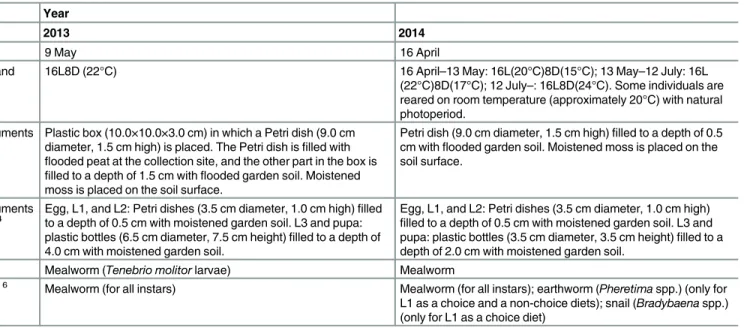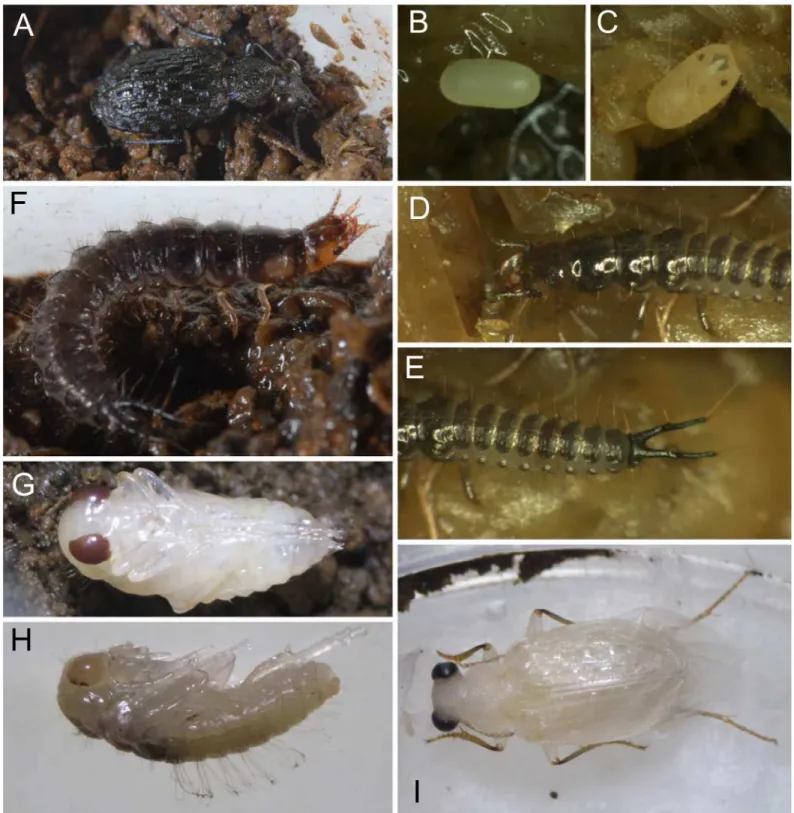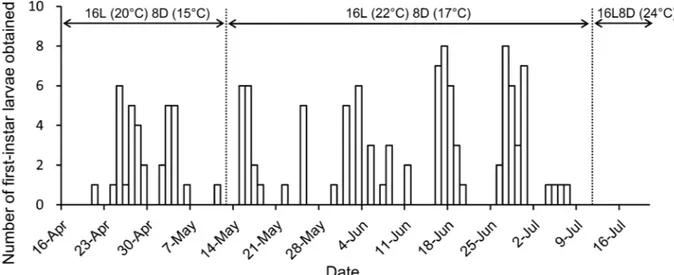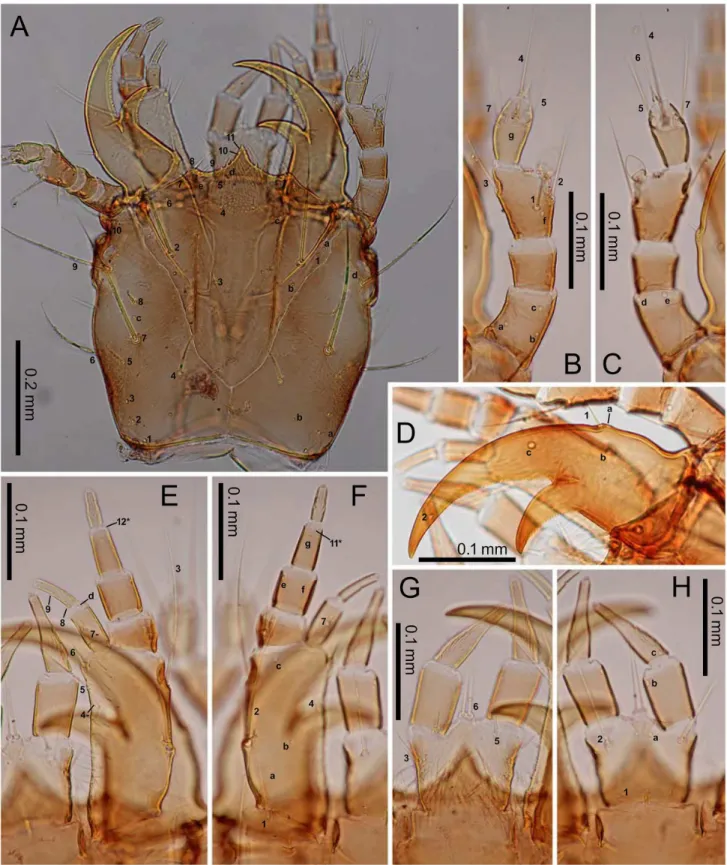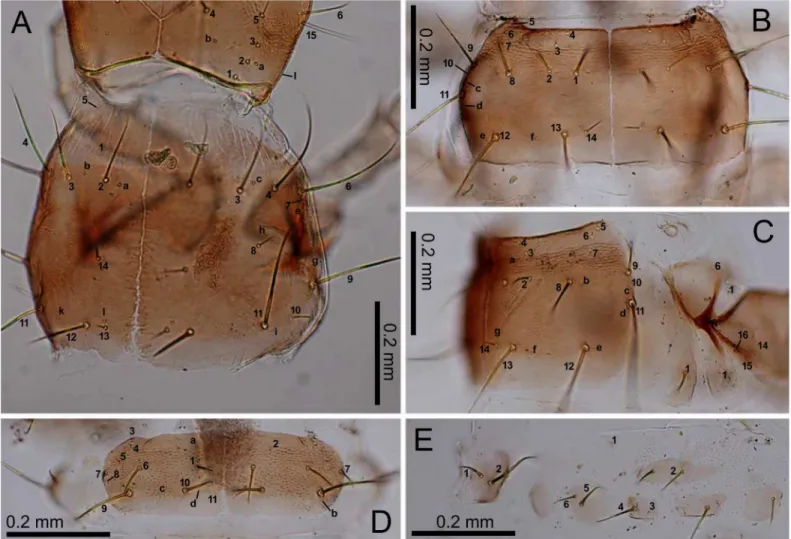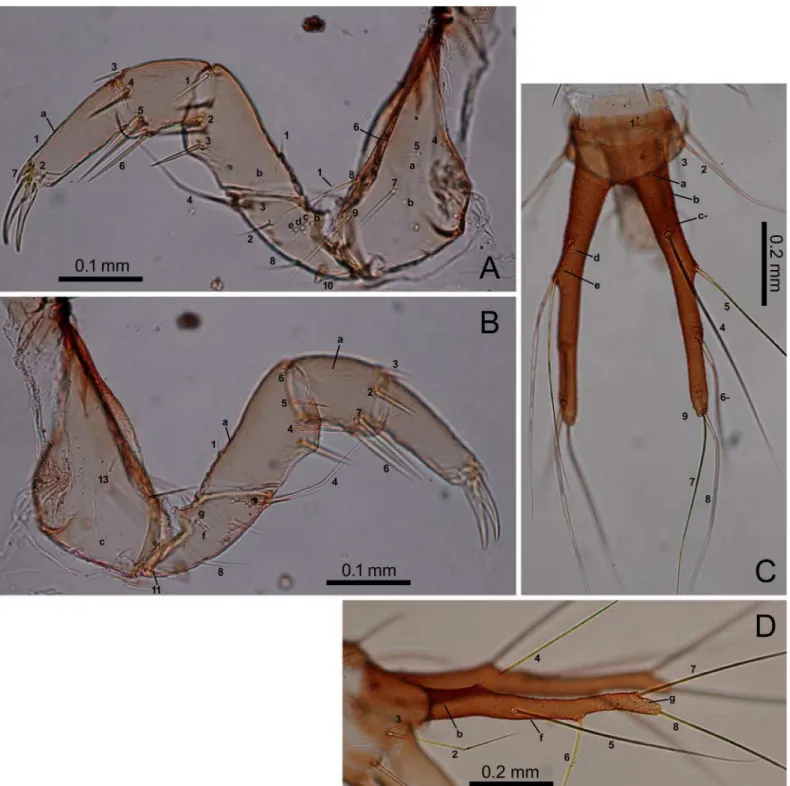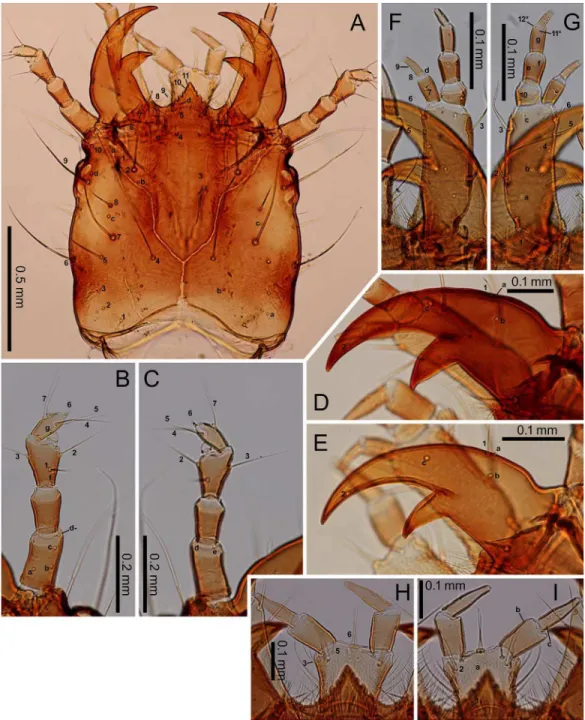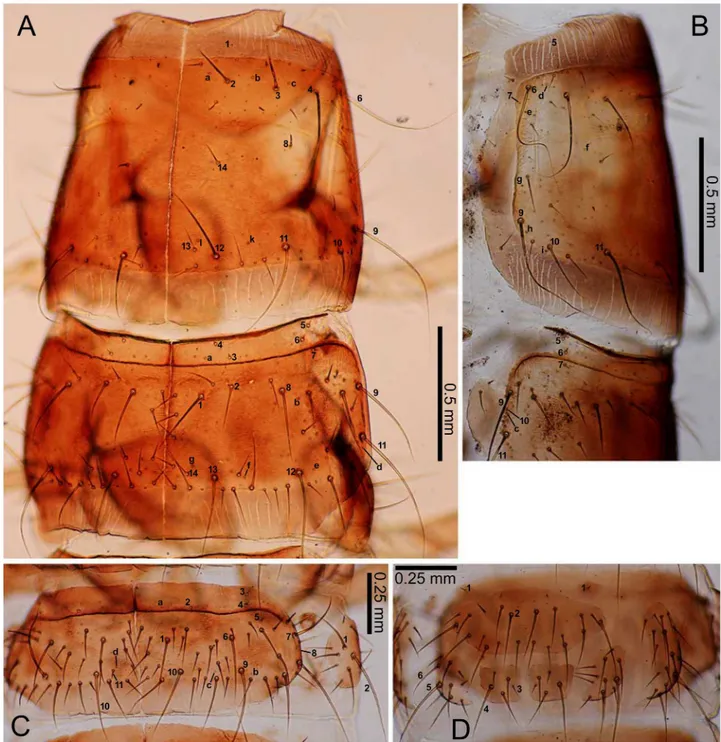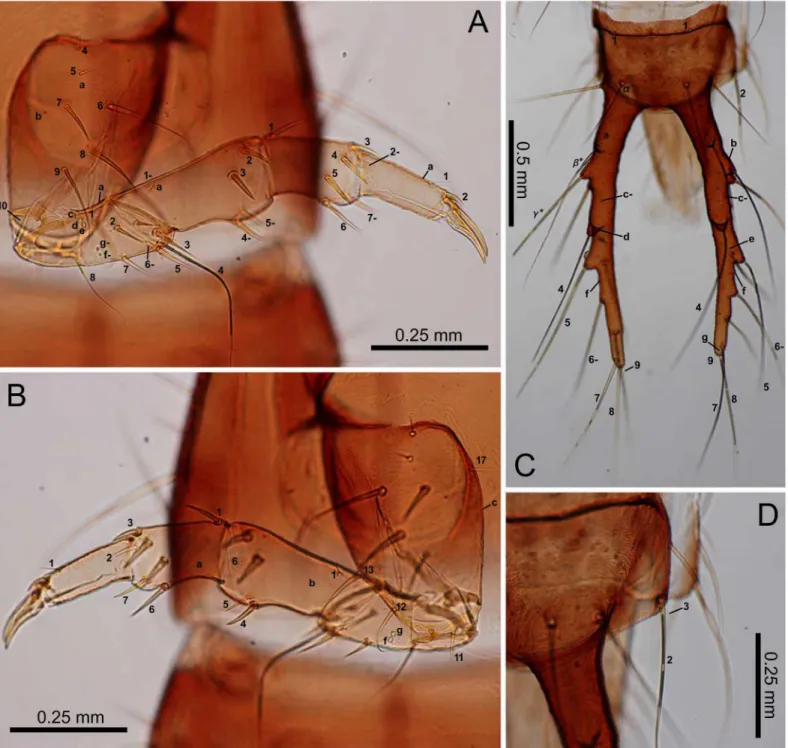RESEARCH ARTICLE
Notes on the Reproductive Ecology and
Description of the Preimaginal Morphology
of
Elaphrus sugai
Nakane, the Most
Endangered Species of
Elaphrus
Fabricius
(Coleoptera: Carabidae) Ground Beetle
Worldwide
Kôji Sasakawa1,2
*
1Laboratory of Zoology, Department of Science Education, Faculty of Education, Chiba University, Yayoi-cho, Inage-ku, Chiba, Japan,2Department of General Systems Studies, Graduate School of Arts and Sciences, University of Tokyo, Komaba, Meguro-ku, Tokyo, Japan
*ksasa@chiba-u.jp
Abstract
Elucidating the basic life-history of endangered species is the first important step in the con-servation of such species. This study examined the reproductive ecology and the preimagi-nal morphology of the endangered ground beetleElaphrus sugaiNakane (Coleoptera: Carabidae); currently, the Watarase wetland of the central Kanto Plain, Japan is the only confirmed locality of this beetle species. Laboratory rearing of reproductive adults collected in early April revealed that females can lay more than 131 eggs. Eggs were laid in mud, without an egg chamber. Larvae reached adulthood when fed a diet of mealworms, indicat-ing thatE.sugailarvae are insect larvae feeders. An earthworm diet, the optimal diet for lar-vae of a congeneric species (E.punctatusMotschulsky), was lethal toE.sugailarvae. The egg stage was 3–4 days in duration under a 16L8D cycle (22°C). The duration from hatch-ing to adult eclosion was 23–42 days at various temperatures simulating those of the repro-ductive period. Larval morphology was similar to that of consubgeneric species described previously. The pupa is unusual, in that the setae on the abdominal tergites are long (twice as long as those of the abdominal segment) and have somewhat“coiled”apices. Finally, the current endangered status ofE.sugaiwas compared to that ofE.viridisHorn, which has been regarded as the most endangered species of the genus worldwide.
Introduction
Environmental degradation caused by human activities and the resulting increases in extinc-tion risks are problematic worldwide, including Japan. The current (2012–2013) Red List
a11111
OPEN ACCESS
Citation:Sasakawa K (2016) Notes on the Reproductive Ecology and Description of the Preimaginal Morphology ofElaphrus sugaiNakane, the Most Endangered Species ofElaphrusFabricius (Coleoptera: Carabidae) Ground Beetle Worldwide. PLoS ONE 11(7): e0159164. doi:10.1371/journal. pone.0159164
Editor:Claude Wicker-Thomas, CNRS, FRANCE
Received:March 25, 2016
Accepted:June 28, 2016
Published:July 14, 2016
Copyright:© 2016 Kôji Sasakawa. This is an open access article distributed under the terms of the
Creative Commons Attribution License, which permits unrestricted use, distribution, and reproduction in any medium, provided the original author and source are credited.
Data Availability Statement:All relevant data are within the paper.
Funding:This study was supported by the Japan Society for the Promotion of Science (no. 25830150),
https://kaken.nii.ac.jp/d/p/25830150.en.html.
prepared by the Japanese Ministry of the Environment lists 3,597 species as threatened (i.e., “Critically Endangered”,“Endangered”, and“Vulnerable”), compared with the 3,155 species of the 2007 list, reflecting addition of over 400 species [1,2]. The current number of threatened insect species is 1.50-fold higher than that in the 2007 list (an increase from 239 to 358 species). This rate of increase is highest in ten taxa examined, namely mammals, birds, reptiles, amphib-ians, brackish-water/freshwater fishes, insects, shellfish, other invertebrates (arachnids, crusta-ceans, etc.), plants I (vascular plants), and plants II (nonvascular plants). Among the insect groups, ground beetles (Coleoptera: Carabidae) and moths (Lepidoptera) that inhabit wetlands or grasslands and water beetles (Coleoptera: Dytiscidae, Gyrinidae) that inhabit paddy fields or storage ponds are severely threatened [1]. Elucidating basic information such as the precise range and life history is the first essential step in conservation.
Elaphrus sugaiNakane is a small carabid (about 8 mm in body length) that inhabits wet-lands and is listed as“Endangered”in the current Red List [3]. The species has been recorded from two wetlands located in the central Kanto Plain, but there have been no records since 1952 from one of these two localities (the Sugao pond, Ibaraki Prefecture) [4]. Currently, the type locality, the Watarase wetland (Tochigi Prefecture) is the only confirmed locality. The reeds of this wetland have been burned annually for approximately the past 60 years, which has contributed to maintenance of theE.sugaihabitat [5]. However, after the Great East Japan Earthquake of March 11, 2011, burning was cancelled the following 2 years. This, together with recent drying of the wetland environment, may compromise theE.sugaihabitat. Indeed, col-lection of this beetle has not been reported since 2011, despite intensive field surveys by the Government in 2012–2014 [6,7,8].
This study describes the reproductive ecology and preimaginal morphology ofE.sugai, obtained from laboratory rearing using reproductive adults collected in 2013 and 2014. To my knowledge, this was the first formal record of the species since 2011. As the ecology and prei-maginal morphology of the species have not been described previously, the results presented here will aid future conservation efforts.
Materials and Methods
The preimaginal stages were described based on photographs and specimens of some indi-viduals. Color descriptions are based on color photographs of live individuals at all stages. Morphological descriptions are based on photographs of live eggs, slide-mounted and etha-nol-preserved larval specimens (respectively, for detailed morphological observation and measurement), and photographs of live pupae and pupae fixed in absolute ethanol and pre-served in 70% ethanol. For slide-mounted larval specimens, five first-instar, two second-instar, and three third-instar individuals were mounted as follows. First, live or freshly-dead individuals were fixed by boiling in water for a few minutes and subsequently preserving in 70% ethanol. Next, the specimens were partly disarticulated, cleaned with 10% potassium hydroxide solution overnight, and dehydrated in absolute ethanol. They were next mounted on glass slides, under cover slips, using Euparal. To prevent deformation by compression, a “frame”of wood fragments or metallic staples was placed between the slide and the cover slip. Other larval specimens were fixed by boiling in water for a few minutes and preserved in 70% ethanol.
The terminology used for most structures follows that of Bousquet & Goulet [9] and Bous-quet [10]. Secondary setal counts for the following structures represent counts from both sides combined, unless otherwise stated: the pro-, meso- and meta-notum; abdominal tergites I– VIII; the prosternite; the median sternite; the sternal sclerite; and the pygidium (both dorsal and ventral). The counts of some secondary setae exhibiting marked individual variations (e.g., thoracic nota) were described using the following four categories of Bousquet & Smetana [11]: few (less than 6), moderately numerous (6–15), numerous (16–40), and very numerous (more than 40).
Table 1. Condition of laboratory rearing of adult and larvalE.sugai. Year
2013 2014
Starting date 9 May 16 April
Photoperiod and temperature
16L8D (22°C) 16 April–13 May: 16L(20°C)8D(15°C); 13 May–12 July: 16L
(22°C)8D(17°C); 12 July–: 16L8D(24°C). Some individuals are reared on room temperature (approximately 20°C) with natural photoperiod.
Rearing instruments
for adults1, 2 Plastic box (10.0×10.0×3.0 cm) in which a Petri dish (9.0 cmdiameter, 1.5 cm high) is placed. The Petri dish is
filled with
flooded peat at the collection site, and the other part in the box is
filled to a depth of 1.5 cm withflooded garden soil. Moistened moss is placed on the soil surface.
Petri dish (9.0 cm diameter, 1.5 cm high)filled to a depth of 0.5 cm withflooded garden soil. Moistened moss is placed on the soil surface.
Rearing instruments
for larvae1, 3, 4 Egg, L1, and L2: Petri dishes (3.5 cm diameter, 1.0 cm high)to a depth of 0.5 cm with moistened garden soil. L3 and pupa:filled plastic bottles (6.5 cm diameter, 7.5 cm height)filled to a depth of 4.0 cm with moistened garden soil.
Egg, L1, and L2: Petri dishes (3.5 cm diameter, 1.0 cm high)
filled to a depth of 0.5 cm with moistened garden soil. L3 and pupa: plastic bottles (3.5 cm diameter, 3.5 cm height)filled to a depth of 2.0 cm with moistened garden soil.
Adult diet5, 6 Mealworm (Tenebrio molitorlarvae) Mealworm
Larval diet3, 5, 6 Mealworm (for all instars) Mealworm (for all instars); earthworm (Pheretimaspp.) (only for L1 as a choice and a non-choice diets); snail (Bradybaenaspp.) (only for L1 as a choice diet)
1
Peat and garden soil are frozen at least 24 hours to prevent“biotic contamination”. 2
The instrument was replaced at 3–4 day intervals to prevent predation by adult on eggs and hatched larvae. 3L1, L2, and L3 denote thefirst, second, and third-larval instars, respectively.
4
Death and molting are checked daily. 5
Diet is provided at anad libitumfeeding level and replaced on a daily basis. 6All diets are cut into piece immediately after being killed.
doi:10.1371/journal.pone.0159164.t001
Fig 1. Life history ofE.sugai.(A) Reproductive female in 2013, (B) an egg laid within 24 h, (C) a 2-days old egg, (D) the anterior half of a first-instar larva, (E) the posterior half of the same first instar individual, (F) a third-instar larva, (G) a pupa, (H) another pupa from lateral view, to show setae on the dorsal side, (I) a newly-emerged adult. The photos vary in magnification.
Results
Ovipositioning behavior and fecundity
Twenty larvae were obtained from the female in 2013 (Fig 1A). Of these, three were obtained from eggs laid on moistened moss (Fig 1B and 1C), and one from eggs laid on flooded garden soil (i.e., mud). The remaining 16 individuals could not be found at the egg stage, but were found on mud after hatching (Fig 1D and 1E). In 2014, 131 larvae were obtained from one female and 4 from the other female. All larvae were found on mud after hatching. Although the soil in the rearing cages was checked carefully, egg chambers, which have been reported in other carabids [12], were not found.
For the 2013 female, the first larvae hatched on May 15 (6 days after the start of the experi-ment) from one of two eggs laid on moistened moss on May 12. The second larva hatched on the same day, and subsequent larvae were obtained on May 15 (two individuals), 19 (two), 30 (five), and 31 (four) and June 1 (three), 3 (one), 4 (one) and 5 (two). The fecundity (the number of first-instar larvae obtained per day) was thus 0.95. Of the 131 larvae from the 2014 female, the first was obtained on April 21 (5 days after the start of the experiment). Then, one to eight indi-viduals were obtained daily at 1–5-day intervals until 7 July (Fig 2). The fecundity was thus 1.70.
Larval feeding habits
Because there was no information on larval feeding habits, all three major types of carabid lar-val diet (insect larvae, earthworms, and snails/slugs) were provided simultaneously to early hatchlings in 2013. Following Sasakawa [13], commercial mealworms (Tenebrio molitor lar-vae),Pheretimaearthworms, andBradybaenasnails were provided. First-instar larvae ate the mealworms only; thus only mealworms were provided in later work. Most larvae reached sub-sequent developmental stages, and one became adult (Table 2; note that in 2013, almost half of all larvae were killed [specimens]). In 2014, most larvae were reared on only the mealworm diet and some reached adulthood (Table 3). In both 2013 and 2014, larval mortality was higher in first-instar larvae than in others due to mold on the substrate and/or diet.
The earthworm diet was reexamined in 2014, because successful rearing to adulthood using only an earthworm diet had then been confirmed in a congeneric species,Elaphrus punctatus Fig 2. Numbers of first-instar larvae obtained from eggs laid by a female in 2014.Most larvae were obtained within 24 h of hatching.
doi:10.1371/journal.pone.0159164.g002
Motschulsky (Sasakawa, unpublished data). Only earthworms were provided to two 1-day old, unfed second-instarE.sugaithat had been reared on a mealworm diet in the first-instar. Under this no-choice condition, the larvae eventually ate some earthworms but died the next day.
Developmental durations
The following insect individuals were not used when calculating the duration of each develop-mental stage, because their hatching or molting dates were ambiguous: (i) eggs found appar-ently after being laid; (ii) first instars found after hatching; and (iii) individuals that molted in the soil. Consequently, few data were available, because most hatching, pupation, and adult eclosion occurred in soil. The number of days [mean (min–max, n)] at the egg stage was 3.3 (3–4, n = 3) at 16L8D (22°C). The durations of the first instar were 4.0 days (3–5 days, n = 2) at 16L8D (22°C), 5 days (n = 1) at 16L (22°C) 8D (17°C), and 5.0 days (4–6 days, n = 4) at 16L (20°C) 8D (15°C). The durations of the second instar were 6.5 days (5–8 days, n = 2) at 16L8D (22°C), 5.4 days (3–10 days, n = 10) at 16L (22°C) 8D (17°C), and 7.0 days (5–8 days, n = 3) at 16L (20°C) 8D (15°C). The durations of the third instar and pupa were 12 days and 4 days (both n = 1), respectively, at 16L8D (22°C).
Although the hatching dates were unclear, the time from first-instar entry to adult eclosion was 26 days for the adult that emerged in 2013. For the 10 adults that emerged in 2014, these times were 16, 19, 21, 23, 24 (three individuals), 25, 28, and 42 days. Of these, the 16-, 19-, and 21-day individuals took only 0–3 days before molting to the second-instar, indicating that these individuals were found several days after hatching. Thus, their data may be unreliable. The time from hatching to adult eclosion was therefore 23–42 days
Descriptions of the preimaginal stages
Figs1B–1Hand3–8
Eggs. Immediately after laying (<24 h), 0.5–0.6×1.1–1.2 mm in diameter and light cream in color; just before hatching, 0.65×1.3 mm in diameter and, overall, yellowish-cream in color with the following characters of the embryo visible through the shell: the egg-bursters and their surrounding regions grey in color, brown stemmata, and yellowish-brown mandibular and retinacular apices.
Table 2. Larvae reared in 2013.
L1 L2 L3 Pupa Adult
Number of individuals
At the initial phase of each developmental stage 20 11 8 3 1 (♀)
Mortalities at each developmental stage 5 1 0 2 –
Killed as specimens 4 2 5 0 –
doi:10.1371/journal.pone.0159164.t002
Table 3. Larvae reared in 2014.
L1 L2 L3 Pupa Adult
Number of individuals
At the initial phase of each developmental stage 135 46 22 11 10 (6♂4♀)
Mortalities at each developmental stage 85 241 5 1 (♀) –
Killed as specimens 4 0 6 0 –
1
Two individuals on the earthworm diet are included.
Fig 3. First-instarE.sugai.(A) Head capsule (dorsal view), (B) antenna (dorsal view), (C) antenna (ventral view), (D) right mandible (dorsal view), (E) maxilla (dorsal view), (F) maxilla (ventral view), (G) labium (dorsal view), (H) labium (ventral view). The homology of characters marked with an asterisk (*) is uncertain, and in Fig 3E, characters with a hyphen (-) are on the ventral side.
doi:10.1371/journal.pone.0159164.g003
Larvae. Characters present in all instars: head capsule with a dark-brown dorsal surface, except for the lateral areas behind the stemmata that are roughly surrounded by PA6–PA9, and
the posterior area near the base, the anterior margin of which lies posterior to PAb; dark-brown
antennae and mandibles; yellowish-brown maxilla, labium, other parts of the head capsule, and the legs; blackish-gray sclerites on the meso- and meta-thorax and abdomen; dark-gray urogomphi; grayish white membranous parts (Figs4–6). Most primary setae and pores present, but at least LA5and PRjabsent. Secondary setae and pores present on antennomere II (one
pore on the ventral side), maxillary palpomere IV (5–7 minute setae/pores), galeomere II (one seta on the middle of the inner side, and one pore on the outer side near the apex). Head cap-sule subquadrate, the length along the median line as long as the width at the widest point. The frontale V-shaped at the base, with the posterior end at the level of the (approximately) basal one-fifth of the head capsule (along the median line of that capsule); the nasale triangular, dis-tinctly prominent; the length from the tip along the median line to the level of FR5as long as
that along the median line from the level of FR5to FR4; 2–4 additional teeth on the lateral
mar-gins posterior to FR10; the adnasale sloping at less than 45°. The parietale with six stemmata;
the lateral side (viewed dorsally) swollen at the levels of PA10and the stemmata, slightly sinuate
Fig 4. First-instarE.sugai.(A) Head capsule (part) and pronotum (right dorsolateral view), (B) mesonotum (dorsal view), (C) mesothorax (right lateral view), (D) abdominal tergite I (dorsal view), (E) median, inner, and outer sternites, and epipleurite.
behind PA6; the cervical groove absent; a coronal suture present. Antennae as long as the
man-dible; antennomeres I and III subequal in length, longer than antennomeres II and IV; anten-nomeres I and II cylindrical; antennomere IV and the sensorial appendage on antennomere III claviform. The mandible moderately arcuate anteriorly, the basal width 0.35–0.4-fold the Fig 5. First-instarE.sugai.(A) Fore leg (anterolateral view), (B) fore leg (posterolateral view), (C) abdominal tergite IX and urogomphi (dorsal view), (D) abdominal tergite IX and urogomphi (left lateral view). In Fig 5C, characters with a hyphen (-) are on the dorsal side.
doi:10.1371/journal.pone.0159164.g005
length of the mandible along the median line; the retinaculum located slightly behind the mid-dle of the mandible, with the basal width one-third that of the mandible and the length along the median line 20–25% that of the mandible. The maxilla with a stipe longer than palpomeres I–IV combined; palpomeres II and III and galeomere I subequal in length, longer than palpo-meres I and IV; membranous notch absent; lacina absent; gMX with at least 20 setae. Labium Fig 6. Second- and third-instarE.sugai.(A) Head capsule of instar (dorsal view), (B) antenna of third-instar (dorsal view), (C) antenna of third-third-instar (ventral view), (D) right mandible of third-third-instar (dorsal view), (E) right mandible of second-instar (dorsal view), (F) maxilla of third-instar (dorsal view), (G) maxilla of third-instar (ventral view), (H) labium of third-instar (dorsal view), (I) labium of third-instar (ventral view). The homology of characters marked with an asterisk (*) is uncertain, and in Fig 6B, the characters with a hyphen (-) is on the ventral side.
with a subquadrate prementum; prementum slightly wider anteriorly; palpomere II slightly longer than palpomere I, but shorter than the prementum; the ligula small; palpomere II with >10 longitudinal channels on the outer side of the basal 75%; the length of the channels
approximately half the diameter of the basal end of palpomere II. The thoracic nota and the abdominal tergites transverse; the anterior border of the mesonotum with a distinct edge; the pronotum without distinct notal carina. The urogomphi fused to tergite IX, slightly thinner Fig 7. Third-instarE.sugai.(A) Pro- and mesonotum (right dorsolateral view), (B) Pro- and mesonotum (part) (left lateral view), (C) abdominal tergite I and epipleurite (right dorsolateral view), (D) median, inner, and outer sternites.
doi:10.1371/journal.pone.0159164.g007
posteriorly, longer than the pygidium and the head capsule. All legs with two slightly arcuate simple claws subequal in length.
Characters restricted to first-instars: Head width 0.47–0.51 mm (mean±SD: 0.49±0.01 mm, n = 10). The urogomphi 0.58–0.67 mm (mean±SD: 0.64±0.03 mm, n = 11). Pronotum Fig 8. Third-instarE.sugai.(A) Fore leg (anterolateral view), (B) fore leg (posterolateral view), (C) abdominal tergite IX and urogomphi (dorsal view), (D) abdominal tergite IX and urogomphi (part, dorsal view). The homology of characters marked with an asterisk (*) is uncertain, and characters with a hyphen (-) are on the posterolateral side in Fig 8A and on the ventral side in Fig 8C.
entirely blackish gray. Head capsule widest at the stemmata; the lateral sides moderately arcu-ate posteriorly, with the width at the level of PA2narrower than that at the level of PA10; the
posterior margin slightly arcuate anteriorly. The frontale with longitudinal keel-like egg-bursters; additional teeth on the nasale widely spaced, with the interval between teeth as wide Table 4. Fecundity of various taxa of Carabidae.
Taxa Total number of eggs laid in a single breeding season
Egg-laying rate (eggs/day) Source
Cychrus schmidtiChaudoir 20 (mean from four females) 0.33 [14]
Carabus asperatus
(Dejean)
241 (from a female) 4.46 (from a female) [12]
Ca.auratusLinnaeus 56 (mean) – [15]
Ca.cancellatusIlliger 45 (mean) – [15]
Ca.granulatusLinnaeus 41 (mean) – [15]
Ca.stenocephalus stenocephalusLucas
288 (from a female) 5.88 (from a female) [12]
Ca.stenocephalus susicus
Antoine
423–511 (from two females) 4.23–12.46 (from a female) [12]
Ca.stenocephalus ifniensisZarco
342 (from a female) 7.95 (from a female) [12]
Ca.stenocephalus aliai
Escalera
284 (mean from three females) 3.27 (mean from three females) [12]
Ca.ulrichiGermar 22 (mean) – [15]
Abax ovalis(Duftschmid) 15 – [15]
Ab.parallelusDuftschmid 32–48 (mean)1 [15]
Poecilus chalcites(Say) 351 (mean) – [15] asPterostichus
chalcitesSay
Po.cupreus(Linnaeus) – 0.2–0.92 [16]
Po.fortipes(Chaudoir) 54 (from a pair) – [17]
Po.versicolor(Sturm) 77.5 (mean in thefirst year) – [18]
Pterostichus angustatus
(Duftschmid)
105 (mean of bred females); 136 (mean of trapped females); 320 (max. of bred females); 261 (max. of trapped females)
– [15]
Pt.oblongopunctatus
(Fabricius)
48 (mean of bred females); 65 (mean of trapped females); 129 (max. of bred females); 105 (max. of trapped females)
– [15]
Amara macronota(Solsky) – 1.56 (mean in a pure-animal diet); 1.18 (mean
in a mixed-seed diet); 3.02 (mean in a mixed animal/seed diet)
[19]
Am.similata(Gyllenhal) – 0.94 (mean in a pure-animal diet); 3.12 (mean
in a pure-seed diet); 3.36 (mean in a mixed animal/seed diet)
[20]
Anisodactylus
punctatipennisMorawitz –
1.25 (mean in a pure-animal diet); 4.68 (mean in a mixed-seed diet); 5.87 (mean in a mixed animal-seed diet)
[21]
Harpalus rufipes(Degeer) – 0.020 (mean in a pure-animal diet); 0.502
(mean in a pure-seed diet); 0.650 (mean in a mixed animal/seed diet)
[22]
Agonum sexpunctatum
(Linnaeus)
27.6 (mean in thefirst year) – [15] asAgonum
assimile(Motschulsky)
1Calculated from the information that
“an average of 16 per batch”and“females lay twice, at intervals of one to two months, and occasionally even three times”.
2Calculated from the values inFig 2.
doi:10.1371/journal.pone.0159164.t004
as the width of the teeth; the adnasale slightly sloping. Antennomere IV longer than antenno-mere II. Terebra with minute teeth at the basal 2/3; the posterior edge of retinaculum arcuate, with minute teeth at the basal 4/5. Maxillary palpomeres I and IV subequal in length; galeo-mere I slightly shorter than galeogaleo-mere II; gMX with 20–35 setae. Notal and abdominal tergal carinae absent.
Characters restricted to older instars: Head width 0.59–0.63 mm (mean±SD: 0.62±0.02 mm, n = 4) in second instars, 0.83–0.89 mm (mean±SD: 0.86±0.03 mm, n = 4) in third instars. Uro-gomphi 0.80–0.93 mm (mean±SD: 0.89±0.06 mm, n = 4) in second instars, 1.16–1.28 mm (mean±SD: 1.23±0.05 mm, n = 4) in third instars. Additional secondary setae present on the parietale (seven on the ventral side, between PA11and PAi, between PA12and PA17,
anterome-dial to PAj, behind PAn, medial or anteromedial to PAk, posterolateral to PAk, and
posterome-dial to PA15), the pronotum (numerous in the discal area, mainly around the primary setae and
pores), the meso- and meta-notum (very numerous in the discal area, mainly around the pri-mary setae and pores), abdominal tergites I–VIII (numerous on I–VIII in L2; very numerous on I–VII and numerous on VIII in L3; covering the entire surfaces of the discal area), abdomi-nal tergite IX and the urogomphi (one, occasioabdomi-nally two, on the lateral margin in front of UR2,
one on the lateral side at the base of urogomphi, URα, URβ, URγ, one on the ventrolateral side behind URγ, one on the ventral side at the level of URe, and one on the ventral side between
UR6and UR7), the pygidium (few on the dorsal, numerous on the ventral side), the episternum
(one), the prosternite (4–7 near PS1), the trochantin (one), the pleurite (2–4), the median
ster-nites (1–2 on I and 12–14 on II–VII in L2, few on I and 20–24 on II–VII in L3), the sternal sclerites (numerous, occasionally relatively numerous on segment VIII, few on segment IX), the inner sternite (1–2 in L2, 2–3 in L3), the outer sternite (2–5 in L2, 5–9 in L3), the hypo-pleurite (4 on segment I, 8–11 on II–VII, 5–7 on VII in L2; 8 on I, 15–23 on II–VII, and 13–14 on VIII in L3), the epipleurite (4–10 on II–VIII and 1–3 on IX in L2, 13–21 on II–VIII and 5–7 in L3), the trochanter (one between TR2and TR3). Pronotum large yellowish-brown area on
both lateral sides; other parts of pronotum blackish-gray. Head capsule widest at the level between PA6and PA7, with the lateral sides subparallel; the width at the level of PA2wider
than that at the level of PA10; the posterior margin moderately (second-instar) or strongly
(third-instar) arcuate anteriorly. Additional teeth on the nasale closely spaced, with virtually no interval; the adnasale moderately sloping. Antennomere IV shorter than antennomere II. Terebra almost smooth, occasionally with ambiguous teeth at the basal 1/3; the posterior edge of retinaculum slightly arcuate throughout with ambiguous teeth at the basal 2/3–3/4 (second-instar) or almost straight, bending at the apical 1/6, with smooth surface (third-(second-instar). Galeo-mere I slightly but distinctly longer than galeoGaleo-mere II; gMX with 20–35 setae in the second instar,>35 setae in the third instar. The pronotum with indistinct notal carina; the notal cari-nae of the meso- and meta-notum and the tergal carina of the abdomen distinct; the anterior border of the metanotum with a distinct edge but less developed than that of the mesonotum. The urogomphi with the bases of UR4, UR5, and URγ, and those of the secondary seta behind
URγ, markedly swollen.
Pupae. Yellowish-white except for compound eyes, which gradually become dark-brown until eclosion. The dorsal side with numerous setae, most of which are absent in the adult: head (four on each lateral side: anterior and posterior supraorbital setae, two additional setae near the posterior supraorbital seta), the pronotum (15 on each lateral side: one in the
Discussion
The results revealed thatE.sugaicould lay over 131 eggs. This was the number laid by a female collected in early April, thus early in the reproductive period, and subsequently reared under stable temperature, photoperiod, and oviposition-substrate conditions. Therefore, in the field (under fluctuating conditions), fecundity may be lower. Moreover, as reported for other cara-bids, fecundity may differ among individuals. Indeed, the egg-laying rate per day of the 2014 female was 1.8-fold higher than that of the 2013 female. Although the other 2014 female laid only four eggs, this was likely an artifact caused by unidentified physiological/environmental conditions and does not reflect the actual fecundity. Compared with other carabids, the fecun-dity ofE.sugaiis not markedly low (Table 4). This suggests that low fecundity is not the princi-pal reason whyE.sugaiis endangered.
Although some eggs were laid on moistened moss and mud, this is probably abnormal or uncommon. This is because the eggshell is as soft as those of other carabids that lay eggs in the soil, and because all other eggs were observed to be laid in mud. It might be assumed that eggs laid in mud would suffocate. However, ovipositioning into mud has been reported in other riparian carabids (Carabus clatratus: [23];Bembidion velox: [24];Nebria yatsugatakensis: [25]). Notably, inB.velox, it has been shown experimentally that eggs survive better under flood con-ditions [24]. This may also be true ofE.sugai. If so, maintenance of a suitable ovipositioning environment is vital in terms of conservation. Experimental studies exploring ovipositioning substrate preferences and the relationships between flooding and offspring survival are required; such work has been performed in other riparian carabids [23,24,26].
Larval rearing showed thatE.sugailarvae are insect larvae feeders. As diet types/conditions differ between the laboratory and the field, this result requires further investigation. In the lab-oratory, mealworms cut into pieces were provided toE.sugailarvae. In the field, however, much smaller live animals will be consumed. The observed high mortality of first-instar larvae (Tables2and3) may be an artifact due to this difference in diet type/conditions between the laboratory and the field, because mealworms cut into pieces become moldy more readily than do live prey. Examinations of candidate prey in theE.sugaihabitat and subsequent laboratory rearing experiments would elucidate this issue. Moreover, stable isotope analysis of field-col-lected samples would be helpful, because the field diets of other carabids have been explored using this method [27,28]. This study describes the preimaginal morphology ofE.sugai, allow-ing field samples to be identified and collected. The earthworm diet was toxic to larvae. Although some carabids eat a non-optimal diet as a supplemental diet and gain some benefits (e.g., a pure-animal diet for granivorous carabids [29]),E.sugailarvae will not eat earthworms even as a supplemental diet in the field.
The larval morphology ofE.sugaiis similar to that of consubgeneric species described pre-viously [30]. However, the morphology differs from that of the sympatricE.punctatus (belong-ing to another subgenus) in terms of the shape of the mandible, which is less arcuate inE.sugai thanE.punctatus[for mandible shape ofE.punctatus, [13]Fig 1A(dorsal view of right mandi-ble of the first-instar) and [31] (coordinates for the contour of right mandible of all instars)]. For eggs and pupae, to my knowledge, this is the first morphological description for a species of the subfamily Elaphrinae. In terms of the pupae, compared with other carabids (Cychrus schmidti[14];Carabus asperatus,Ca.stenocephalus susicus,Ca.stenocephalus aliai[12];Ca. rugosus baeticus[32];Ca.blaptoides[18];Ca.vanvolxemi[33];Loricera pilicornis[34]; Loxan-drus oophagus[35];Macracanthus brevicillus[36];Galerita janus[37];Agonum quandripunc-tatum[38]), the somewhat coiled apices of the setae on the abdominal tergites are unique toE. sugai. The relative length of the setae (compared with the length of the abdominal segments) is also unusual. The length is twice that of an abdominal segment. In all but one other species, the
setal length is shorter than that of an abdominal segment. The exception isLoricera pilicornis [34], in which the setae are twice as long as an abdominal segment, similar toE.sugai. As both E.sugaiandL.pilicornisare species of saturated soil habitats, long setae on the abdominal ter-gites may be associated with the habitat conditions.
MostElaphrusspecies occur in marsh/riparian environments, which are often damaged by human activity and are thus endangered. Among such species,E.viridisHorn of North Amer-ica is one of the four carabids included in the IUCN Red List and is classified as“Critically Endangered”[39]. Therefore,E.viridishas been regarded as the most endangeredElaphrus worldwide. However, given its current distribution and the minimal conservation efforts being made,E.sugaiis probably more endangered. According to available information,E.viridisis thought to occupy a maximal area of 28 km2[40], which is nearly identical to the area of the Watarase wetland (28.5 km2), within which only a few small sites serve as appropriateE.sugai habitats (note that a large artificial lake was excluded when calculating the area of the Watarase wetland). Thus, the area of suitable habitat is apparently smaller in the case ofE.sugaithan in that ofE.viridis. More importantly, conservation efforts differ markedly between the two spe-cies.E.viridisis classified as“threatened”by the U.S. Fish and Wildlife Service; specimen col-lection and habitat disturbance are strictly prohibited. ForE.sugai, however, collection is not prohibited, and no law seeks to protectE.sugaihabitats. As noted in the Introduction, theE. sugaisituation is deteriorating rapidly, and conservation measures are urgently needed. The current data on reproductive ecology and preimaginal morphologies constitute valuable basic information facilitating conservation.
Acknowledgments
I thank Dr. D.H. Kavanaugh (California Academy of Sciences, CA, U.S.A.) and Dr. T. Kishi-moto (Museum of Natural and Environmental History, Shizuoka, Japan) for recent informa-tion ofE.viridisandE.sugai, respectively. The present study was partly supported by a grantin-aid from the Japan Society for the Promotion of Science (no. 25830150).
Author Contributions
Conceived and designed the experiments: KS. Performed the experiments: KS. Analyzed the data: KS. Contributed reagents/materials/analysis tools: KS. Wrote the paper: KS.
References
1. Ministry of the Environment of Japan. Press release: The fourth version of the Japanese Red Lists. 2012. Available:https://www.env.go.jp/press/15619.html(in Japanese).
2. Ministry of the Environment of Japan. Press release: The fourth version of the Japanese Red Lists on brackish-water/freshwater fishes. 2013. Available:https://www.env.go.jp/press/16264.html(in Japanese).
3. Kishimoto T (2015)Elaphrus sugai Nakane, 1987. In: Ministry of the Environment (Japan), editor. Red Data Book 2014.—Threatened Wildlife of Japan—Volume 5, Insecta. Tokyo: GYOSEI Corporation; 2015. P. 91. (in Japanese with English summary)
4. Kurata K. OnElaphrus sugaifrom the Sugao pond, Ibasaki Prefecture, Japan. Ruriboshi. 2012; 41: 87–
91.
5. Editing committee of the History of Fujioka town. History of Fujioka town. Fujioka town: the mayor of Fujioka town; 2002.
6. Monitoring Committee for Wetland Conservation and Restoration in the Watarase Flood Control Basin. Conference material no. 7 for the 5th meeting: Research on insects in the Watarase Flood Control Basin. 2012. Available:http://www.ktr.mlit.go.jp/ktr_content/content/000086847.pdf(in Japanese).
8. Monitoring Committee for Wetland Conservation and Restoration in the Watarase Flood Control Basin. Conference material no. 6 for the 9th meeting: Annual report on the results of monitoring (interim report). 2014.http://www.ktr.mlit.go.jp/ktr_content/content/000113777.pdf(in Japanese)
9. Bousquet Y, Goulet H. Notation of primary setae and pores on larvae of Carabidae (Coleoptera: Ade-phaga). Can J Zool. 1984; 62: 573–588.
10. Bousquet Y. Morphologie comparée des larves de Pterostichini (Coleoptera: Carabidae): descriptions et tables de détermination des espèces du Nord-Est de l'Amérique du Nord. Nat Can. 1985; 112: 191–
252.
11. Bousquet Y, Smetana A. A description of the first instar larva of Promecognathus Chaudoir (Coleop-tera: Carabidae). Syst Entomol. 1986; 11: 25–31.
12. Busato E, Ghittino C, Casale A.Carabusof SubgenusCathopliusC.G. Thomson, 1875, with descrip-tion of their life-way, life-cycle and pre-imaginal morphology (Coleoptera: Carabidae). Zootaxa. 2014; 3866: 451–478. doi:10.11646/zootaxa.3866.4.1PMID:25283670
13. Sasakawa K. Utility of geometric morphometrics for inferring feeding habit from mouthpart morphology in insects: tests with larval Carabidae (Insecta: Coleoptera). Biol J Linn Soc. 2016; 118: 394–409.
14. Busato E. Pre-imaginal stages ofCychrus schmidtiChaudoir, 1837, andCychrus semigranosus Pal-liardi, 1825, with a key to the larvae of the EuropeanCychrusspecies (Coleoptera: Carabidae). Zoo-taxa. 2012; 3361: 1–17.
15. Thiele HU. Carabid Beetles in Their Environments: A Study on Habitat Selection by Adaptations in Physiology and Behaviour. Berlin Heidelberg New York: Springer-Verlag; 1977.
16. Zangger A. The positive influence of strip-management on carabid beetles in a cereal field: accessibility of food and reproduction inPoecilus cupreus. In: Desender K, Loreau M, Maelfait JP, editors. Carabid Beetles: Ecology and Evolution. Dordrecht: Kluwer Academic Publishers; 1994. pp. 469–472.
17. Makarov KV. Annual reproduction rhythms of ground beetles: a new approach to the old problem. In: Desender K, Loreau M, Maelfait JP, editors. Carabid Beetles: Ecology and Evolution. Dordrecht: Kluwer Academic Publishers; 1994. pp. 177–182.
18. Sota T.Carabusin Four Seasons: Life History Evolution and Species Diversity. Kyoto: Kyoto Univer-sity Academic Press; 2000. (in Japanese)
19. Sasakawa K. Effects of maternal diet on fecundity and larval development in the‘primitive’granivorous carabidAmara (Curtonotus)macronota. Entomol Exp Appl. 2009; 130: 106–112.
20. Jørgensen HB, Tøft S. Role of granivory and insectivory in the life cycle of the carabid beetleAmara similata. Ecol Entomol. 1997; 22: 7–15.
21. Sasakawa K. Diet affects male gonad maturation, female fecundity, and larval development in the gra-nivorous ground beetleAnisodactylus punctatipennis. Ecol Entomol. 2009; 34: 406–411.
22. Jørgensen HB, Tøft S. Food preference, diet dependent fecundity and larval development inHarpalus rufipes(Coleoptera: Carabidae). Pedobiologia. 1997; 41: 307–315.
23. Huk T, Kühne B. Substrate selection byCarabus clatratus(Coleoptera, Carabidae) and its conse-quences for offspring development. Oecologia. 1999; 121: 348–354.
24. Kleinwäechter M, Büerkel M. Offspring performance in dynamic habitats: key factors for a riparian cara-bid beetle. Ecol Entomol. 2008; 33: 286–292.
25. Sasakawa K. Two new species of the ground beetle subgenus Sadonebria Ledoux & Roux, 2005 (Coleoptera, Carabidae, Nebria) from Japan and first description of larvae of the subgenus. Zookeys. 2016; in press.
26. Sasakawa K. Peculiar oviposition behavior of the endangered ground beetlePterostichus isumiensis
(Coleoptera: Carabidae) and implications for its conservation. Zool Stud. 2011; 50: 264.
27. Okuzaki Y, Tayasu I, Okuda N, Sota T. Stable isotope analysis indicates trophic differences among for-est floor carabids in Japan. Entomol Exp Appl. 2010; 135: 263–270.
28. Ikeda H, Kubota K, Kagawa A, Sota T. Diverse diet compositions among harpaline ground beetle spe-cies revealed by mixing model analyses of stable isotope ratios. Ecol Entomol. 2010; 35: 307–316.
29. Sasakawa K. Laboratory studies on larval food habits of two syntopic, related, granivorous ground bee-tlesAmara chalcitesandA.congrua(Coleoptera: Carabidae): a comparison with stable isotope analy-sis. Appl Entomol Zool. 2011; 46: 511–518.
30. Goulet H. The genera of Holarctic Elaphrini and species ofElaphrusFabricius (Coleoptera: Carabidae): classification, phylogeny and zoogeography. Quaest Entomol. 1983; 19: 219–482.
31. Sasakawa K. Data from: Utility of geometric morphometrics for inferring feeding habit from mouthpart morphology in insects: tests with larval Carabidae (Insecta: Coleoptera). Dryad Digital Repository. 2015. Available:http://dx.doi.org/10.5061/dryad.mj17h
32. Cárdenas Talaverón AM. Immature stages ofMacrothorax rugosus baeticusDeyrolle, 1852 (Coleop-tera: Carabidae). Elytron. 1993; 7: 123–131.
33. Funakoshi T, Takami Y, Ujiie M, Sota T. The life history ofCarabus vanvolxemi. The Nature and Insects. 1998; 33: 38–43. (in Japanese)
34. Ball GE, Erwin TL. A taxonomic synopsis of the tribe Loricerini (Coleoptera: Carabidae). Can J Zool. 1969; 47: 877–907.
35. Costa C, Vanin SA, De Carvalho TR. A new Brazilian species ofLoxandrusLeConte, 1852, with description of immatures and notes on natural history (Coleoptera: Carabidae: Loxandrini). Zootaxa. 2011; 2745: 30–42.
36. Pavel VR. Larval and pupal characteristics ofMacracanthus brevicillus(Chevrolat) (Coleoptera: Cara-bidae: Masoreini). Coleopt Bull. 2002; 56: 310–314.
37. Dajoz R. Biologie deGalerita janusF. (Coleoptera, Carabidae, Harpalinae). Nouv Revue Entomol. 2005; 22: 283–287.
38. Burakowski B.Agonum (Sericoda) quadripunctatum(De Geer)—a pyrophilous beetle and its immature stages (Coleoptera, Carabidae). Ann Zool (Wars). 1989; 42: 181–194.
39. IUCN. The IUCN Red List of Threatened Species. Version 2015–4. 2015. Available:http://www. iucnredlist.org
